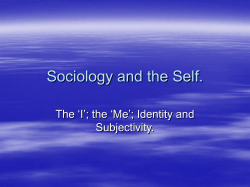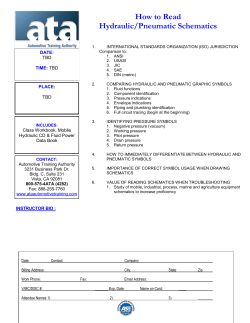
Micro-interactionism The legacy of Pragmatism
Micro-interactionism The legacy of Pragmatism Cardinal numbers of Guaraní (language of indigenous Paraguayans) 1: peteĩ 2: mokõi 3: mbohapy 4: irundy 5: po 6: poteĩ 7: 8: pohapy 9: porundy 10: pa Can you fill in the blanks? 11: pateĩ 12: pakõi 13: pahapy 14: 15: papo 16: 17: papokõi 18: papohapy 19: paporundy 20: mokõipa From structure to agency • structuralists Ferdinand de Saussure (1857-1913) -Linguistic Unlocked the code of ancient languages Claude Lévi-Strauss (born 1908) -Anthropology Found hidden patterns of diverse myths Emergence of structuralism in sociology • Karl Marx “[People] make their own history, but they do not make it just as they please; they do not make it under circumstances chosen by themselves, but under circumstances directly found, given and transmitted from the past.” (The Eighteenth Brumaire of Louis Bonaparte, 1852) Adolescent Karl: “But mom, I want to be an individual! Just like everybody else!” Structure vs. Agency What do YOU think? Are our actions constrained by limits set in place by others so much so that our path in life is narrow and predictable? Or Do we have the ability to navigate the barriers in our way so that we can forge our own path? What might microinteractionists think? Thought exercise Consider a maze: What are your options? What are your limitations? How does structure confine, limit, and determine our fate? Concrete barriers vs. Path of least resistance Question: Who creates the structure? -What might microinteractionists think? The legacy of Pragmatism • “truth” is determined by the practical consequences of our actions – Challenges the idea that objects and ideas have fixed “meanings” – Explains how humans use symbols to communicate and interact – Identifies the existence of multiple social selves Charles Sanders Pierce • Born 1839, died 1914 • Mathematician, scientist, philosopher • Things are true because we believe them to be true. • The meaning of objects and actions are not fixed a priori (in Latin, “from the former”) Thought exercise • A chair – What is this thing? How do you know? • Does it mean the same thing to everyone? How about a carpenter, a weary traveler, a cowboy in a bar fight? What a pragmatist might say: • The objective reality, the fixed meaning of a chair, depends on the practical consequences of chairs in everyday life. • Chairs are for sitting, until the day when people know longer sit in them; at that point, their meaning changes. • If meanings were fixed and unchanging, this wouldn’t happen. Use of symbols • We can only communicate via symbols. • Communication, therefore, is the use of signs and symbols between people – (semiotics = study of signs and symbols). • Who determines meaning? Us. Humans. Pragmatists and symbols • Symbols only make sense in relation to other symbols (just like words only make sense in relation to other words). • A chair means what it does because we agree that it does. In a sociological sense, it not only takes two to tango, it takes two to make meaning. • The symbol of “a chair” only makes sense in relation to other symbols that represent things and actions, such as: “to sit” and “furniture.” Pragmatists and meaning • If symbols only make sense in relation to other symbols, then our social actions only make sense in relation to the actions of others. • We determine what actions to take by predicting and anticipating how others will respond. • The meaning of our own actions is therefore partly determined by how others react to us. Charles Horton Cooley • Born 1864, died 1929 • Most famous idea: “looking glass self” • How do you see yourself through eyes of others? • Thought exercise: picking out your clothes in the morning William James • Born 1842, died 1910 • Offered a theoretical bridge between Idealism and Pragmatism • Argued for the existence of multiple social selves -All guided by a unitary self (soul) • Thought exercise: your social self in your parents home vs a campus party. George Herbert Mead • Born 1863, died 1931 • Published little, but his ideas were very influential (basis of Blumer’s symbolic interactionism). • Contribution: the social mind – Role of games – The “generalized other” – The “me” and “I” of the “self” Generalized other • We account for the “generalized other” in our own thoughts and actions. • Allows us to “interact” socially even when we are thinking by ourselves. • Awareness of others helps us make sense of our own identity (because our own “self” only makes sense in relation to that of others). How can pragmatism help us understand the tension between structure and agency? • In order to understand why people do what they do, we need to have an idea of how they make decisions and what guides their actions (i.e., why do they navigate the structure the way they do?). Phenomenology • The study of “phenomena.” More specifically, the study of how people subjectively interpret, experience, and assign meaning to phenomena. Phenomenology cont. • Lightning bolt exercise • How can it be interpreted objectively and subjectively? – meteorologist vs. cave dweller Alfred Schutz • Born 1899, died 1959 • Part time banker • Influenced by Weber’s concept of verstehen • Our understanding of the social world is subjective • Signs, symbols, and gestures do not have a universal meaning Weber’s woodcutter • You see a person chopping wood in the distance – What are they thinking? – What are they trying to accomplish? – What is their motive? Subjective understanding • What are the clues you use to better understand the woodcutter? – Put yourself in their position (take their role) – Interpret contextual clues (signs, symbols, and gestures) – Superimpose your own experiences and motivations. Limits of subjective understanding • “The subjective meaning that the interpreter does grasp is at best an approximation to the sign-user’s intended meaning, but never that meaning itself, for one’s knowledge of another person’s perspective is always necessarily limited. For exactly the same reason, the person who expresses himself in signs is never quite sure of how [they are] being understood” (p.37). How can phenomenology help us understand the tension between structure and agency? • If the meaning of signs, symbols, and gestures can vary within a given structure depending on the context, then the way we act towards them may also change. – Question: under what conditions might we expect individuals to exercise their agency differently within the same structure? • Ex: university registrar Peter L. Berger and Thomas Luckman • Published in 1966 • Made famous the (now ubiquitous) term “social construction” • Their theory answers the question: where did our social reality come from? Who made the structure we now navigate? – their answer: us! Social Construction of Institutions • Begin as merely “habitualized” actions among people • Patterned actions are first “taken-forgranted” until they eventually “harden” and “thicken” (p.47) Social Construction of Institutions cont. • Interaction rules that serve as the basis of institutions were originally a conscious agreement among actors. However, over time, people do not question their origin. – “Since they had no part in shaping it, it confronts them as a given reality that , like nature, is opaque in places at least” (p.46-7). • With age, institutions become more rigid and inflexibility – “it becomes real in an ever more massive way and it can no longer be changed so readily” (p.46). Thomas theorem • "If [humans] define situations as real, they are real in their consequences.“ – William I. Thomas The child in America: Behavior problems and programs. (1928) • Question: Have you ever witnessed the social construction of an institution? If so, what have been the real consequences for people who conform/deviate from the institution? Herbert Blumer • Born 1900, died 1987 • Played professional football – with now defunct Chicago Cardinals • Pupil of George H. Mead • Coined the term “Symbolic Interactionism” and characterized the theory as a summary of Mead’s ideas Symbolic Interactionism • "Human beings act toward things on the basis of the meanings that the things have for them" • "The meaning of such things is derived from, or arises out of, the social interaction that one has with [others]." • "These meanings are handled in, and modified through, an interpretive process used by the person in dealing with the things he/she encounters." Why is Blumer important? • Symbolic interactionism gives sociologists a framework for understanding why people navigate the prevailing social structure the way we do. – When people are given two, seemingly, equal choices, why pick one over the other? • It depends on how THEY interpret the options in front of them. We need to see the world through THEIR eyes, instead of imposing our own ideas upon them. Blumer’s methodological position • Quantitative vs. Qualitative research – Which might Blumer prefer? Why? Respect the empirical world • “If the scholar wishes to understand the action of people it is necessary for him to see their objects as they see them. Failure to see their objects as they see them, or a substitution of his meanings of the objects for their meanings, is the gravest kind of error that the social scientist can commit” (p.69). Erving Goffman • Born 1922, died 1982 • Studied under Everett Hughes at Chicago – (a colleague of Blumer) • Most famous contribution: dramaturgy • Argued for a renewed focus back on the influence of structure on everyday interactions. Dramaturgy • “Ordinary social intercourse is itself put together as a scene is put together, by the exchange of dramatically inflated actions, counter-actions, and terminating replies. Scripts even in the hands of unpracticed players can come to life because life itself is a dramatically enacted thing. All the world is not, of course, a stage, but the crucial ways in which it isn’t are not easy to specify” (p. 64). Dramaturgy cont. • • • • Front stage Back stage “Parking lots” and “cloak rooms” Authentic vs Cynical presentations of self Onion or artichoke • According to Goffman, is their a “true” self? • Is there a director behind the scenes instructing all the actors? Or • Are there as many “selves” as there are stages?
© Copyright 2025




















